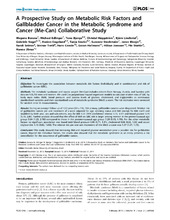| dc.description.abstract | Objective: To investigate the association between metabolic risk factors (individually and in combination) and risk of gallbladder cancer (GBC). Methods: The metabolic syndrome and cancer project (Me-Can) includes cohorts from Norway, Austria, and Sweden with data on 578,700 men and women. We used Cox proportional hazard regression models to calculate relative risks of GBC by body mass index (BMI), blood pressure, and plasma levels of glucose, cholesterol, and triglycerides as continuous standardised variables and their standardised sum of metabolic syndrome (MetS) z-score. The risk estimates were corrected for random error in measurements. Results: During an average follow-up of 12.0 years (SD = 7.8), 184 primary gallbladder cancers were diagnosed. Relative risk of gallbladder cancer per unit increment of z-score adjusted for age, smoking status and BMI (except for BMI itself) and stratified by birth year, sex and sub-cohorts, was for BMI 1.31 (95% confidence interval 1.11, 1.57) and blood glucose 1.76 (1.10, 2.85). Further analysis showed that the effect of BMI on GBC risk is larger among women in the premenopausal age group (1.84 (1.23, 2.78)) compared to those in the postmenopausal age group (1.29 (0.93, 1.79)). For the other metabolic factors no significant association was found (mid blood pressure 0.96 (0.71, 1.31), cholesterol 0.84 (0.66, 1.06) and serum triglycerides 1.16 (0.82, 1.64)). The relative risk per one unit increment of the MetS z-score was 1.37 (1.07, 1.73). Conclusion: This study showed that increasing BMI and impaired glucose metabolism pose a possible risk for gallbladder cancer. Beyond the individual factors, the results also showed that the metabolic syndrome as an entity presents a risk constellation for the occurrence of gallbladder cancer. | en_US |

